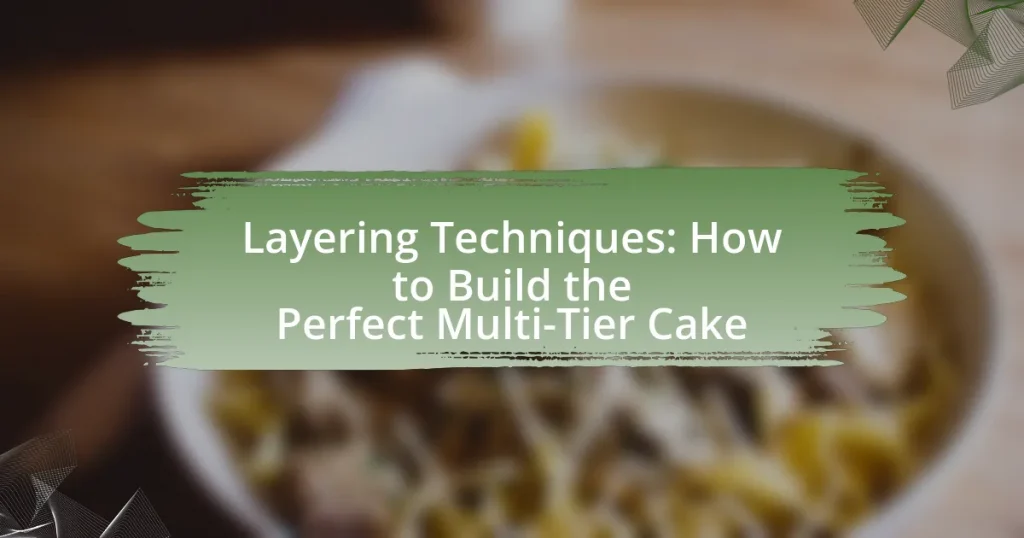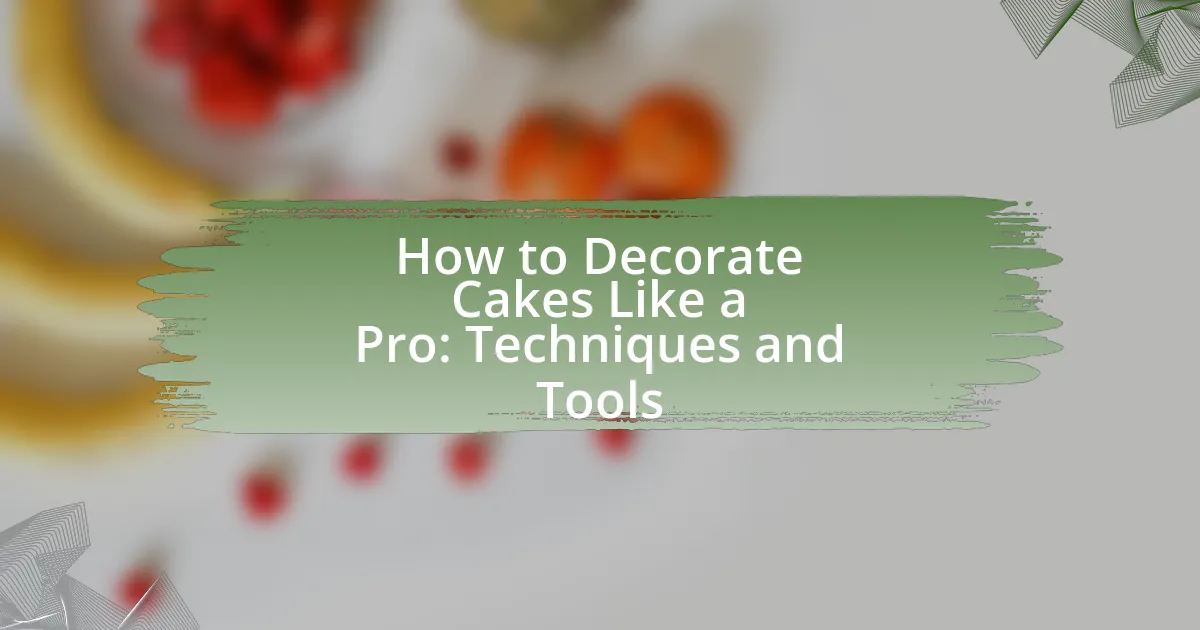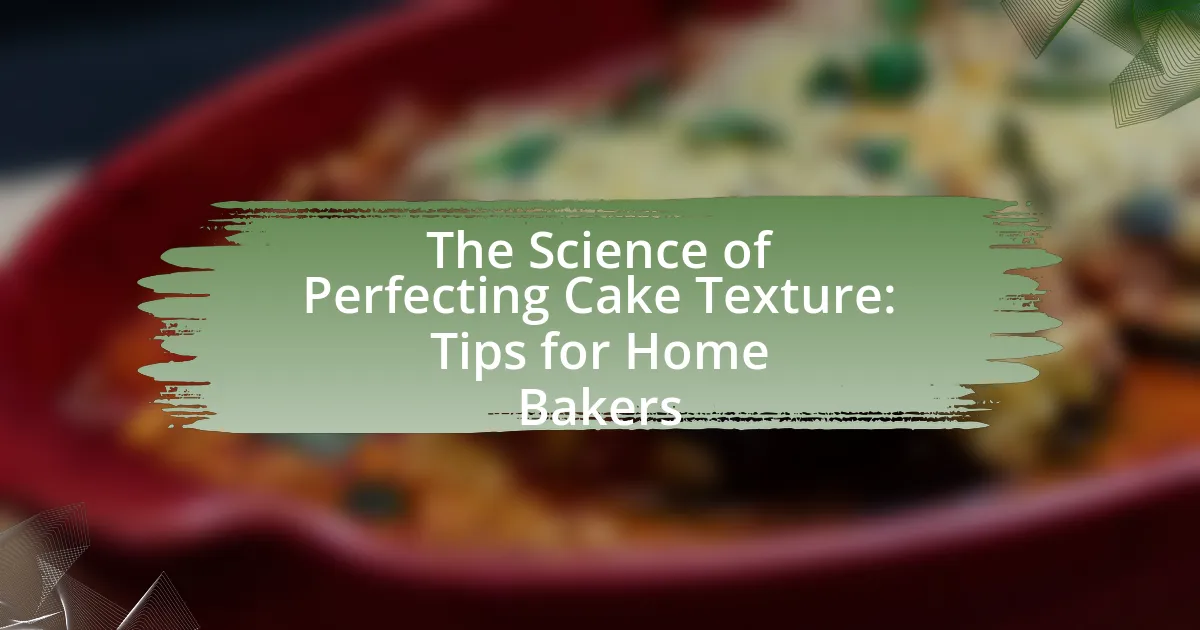Layering techniques for multi-tier cakes are essential for creating visually appealing and structurally sound desserts. This article outlines various methods, including the use of dowels for support and the application of frosting or ganache between layers to enhance flavor and moisture. Key components such as cake layers, fillings, and structural supports are discussed, along with the impact of different techniques on cake stability and appearance. Additionally, the article addresses common challenges bakers face, tips for achieving precise layers, and resources for mastering advanced layering skills, providing a comprehensive guide for both novice and experienced bakers.
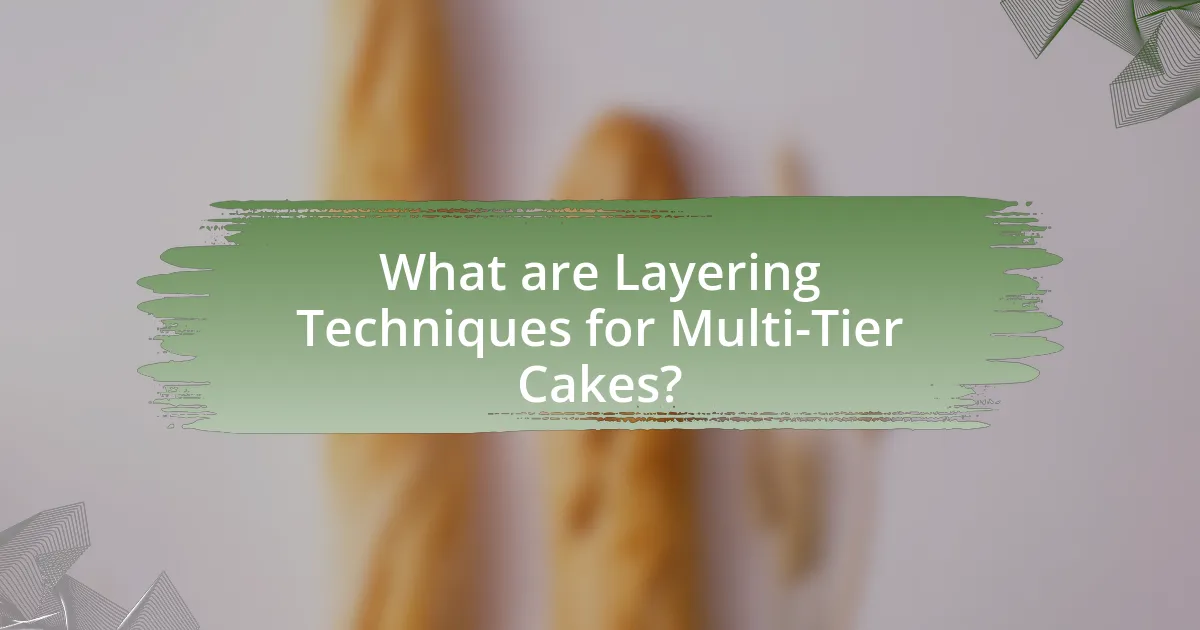
What are Layering Techniques for Multi-Tier Cakes?
Layering techniques for multi-tier cakes involve stacking multiple cake layers with fillings and support structures to create height and stability. Common methods include using dowels or straws for support, applying a layer of frosting or ganache between each cake layer for moisture and flavor, and ensuring each tier is level before stacking. These techniques are essential for maintaining the structural integrity of the cake, especially when it exceeds two tiers, as improper support can lead to collapse.
How do layering techniques enhance the overall cake design?
Layering techniques enhance overall cake design by creating visual depth and dimension. These techniques allow for the incorporation of various flavors, textures, and colors, making the cake more appealing and engaging. For instance, alternating layers of different colored batters or fillings can create a striking visual effect, while varying the thickness of layers can add interest and complexity to the cake’s profile. Additionally, well-executed layering can support structural integrity, ensuring that multi-tier cakes remain stable and aesthetically pleasing. This approach is supported by industry practices where bakers utilize layering to achieve both beauty and functionality in cake design.
What are the essential components of a multi-tier cake?
The essential components of a multi-tier cake include cake layers, filling, frosting, and structural supports. Cake layers provide the base and are typically made from various recipes such as sponge, butter, or chocolate cake. Fillings, which can be fruit preserves, creams, or ganache, add flavor and moisture between the layers. Frosting, often buttercream or fondant, covers the exterior and can also be used for decoration. Structural supports, such as dowels or cake boards, ensure stability and prevent the tiers from collapsing. These components work together to create a visually appealing and structurally sound multi-tier cake.
How do different layering techniques affect cake stability?
Different layering techniques significantly impact cake stability by influencing weight distribution and structural integrity. For instance, using a support system, such as dowels or cake boards between layers, enhances stability by preventing the layers from collapsing under their own weight. Additionally, the choice of frosting consistency can affect stability; a firmer frosting can better hold layers together compared to a softer one. Research indicates that cakes with well-structured layers and proper support systems can withstand greater weight and pressure, reducing the risk of structural failure during transport and display.
Why is it important to master layering techniques?
Mastering layering techniques is crucial for creating visually appealing and structurally sound multi-tier cakes. Proper layering ensures that each tier is stable, preventing collapse during assembly and serving. Additionally, mastering these techniques allows for even distribution of flavors and textures, enhancing the overall taste experience. For instance, cakes that are layered correctly can maintain moisture and prevent dryness, which is essential for customer satisfaction in the baking industry.
What challenges do bakers face when layering cakes?
Bakers face several challenges when layering cakes, including structural integrity, moisture retention, and even distribution of frosting. Structural integrity is crucial; if the layers are not level or stable, the cake may collapse or lean. Moisture retention is another challenge, as dry layers can lead to a crumbly texture, while overly moist layers can cause slippage between tiers. Additionally, achieving even distribution of frosting is essential for aesthetic appeal and flavor balance; uneven frosting can result in a visually unappealing cake and affect the overall taste experience. These challenges require careful planning and execution to ensure a successful multi-tier cake.
How can proper layering techniques improve flavor and texture?
Proper layering techniques enhance flavor and texture by allowing distinct layers of ingredients to interact, creating a more complex taste profile and a pleasing mouthfeel. When cakes are layered correctly, each layer can contribute unique flavors, such as a rich chocolate layer paired with a light vanilla cream, which results in a harmonious blend that elevates the overall dessert experience. Additionally, layering can improve texture by providing contrast; for instance, a moist cake layer combined with a crunchy topping or a creamy filling creates a satisfying combination that engages the palate. This method is supported by culinary principles that emphasize the importance of balance and variety in food preparation, demonstrating that thoughtful layering can significantly impact the enjoyment of multi-tier cakes.
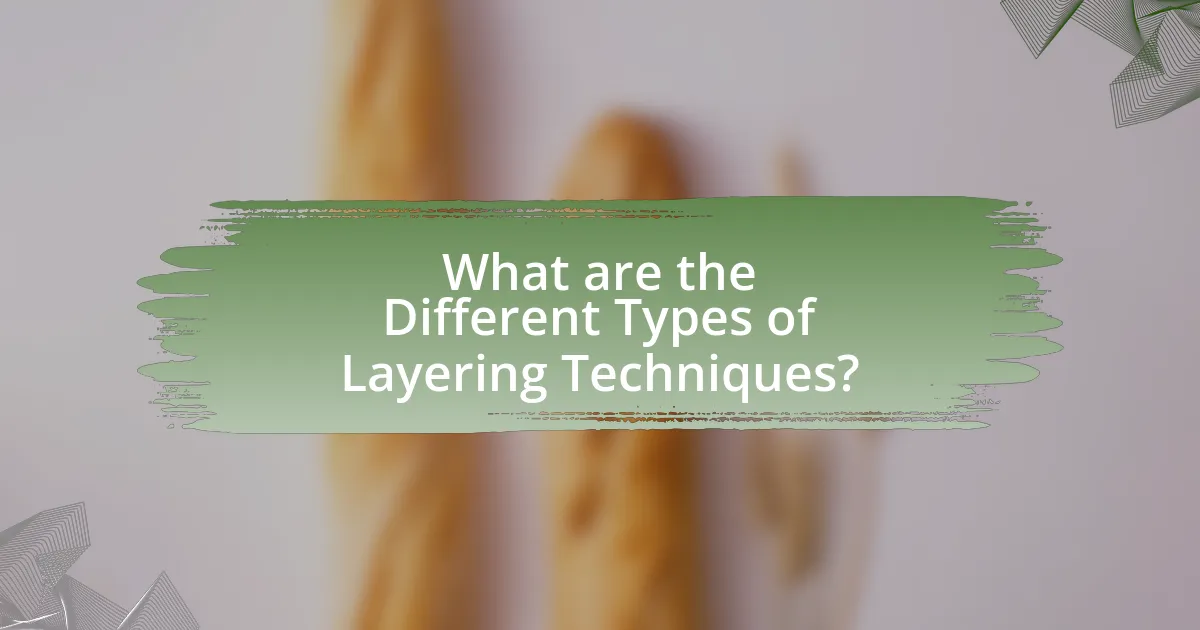
What are the Different Types of Layering Techniques?
The different types of layering techniques for building a multi-tier cake include the following: the traditional stacking method, the dowel support method, and the tiered cake method. The traditional stacking method involves placing one cake layer directly on top of another, which is suitable for smaller cakes. The dowel support method uses dowels inserted into the lower tiers to provide stability for the upper layers, making it ideal for larger cakes. The tiered cake method involves creating separate cake tiers that are assembled on-site, allowing for easier transport and assembly. Each technique is chosen based on the cake’s size, design, and structural needs, ensuring the cake remains stable and visually appealing.
How do you choose the right layering technique for your cake?
To choose the right layering technique for your cake, consider the cake’s structure, flavor combinations, and the desired visual effect. For instance, a sturdy cake like a pound cake is suitable for stacking multiple tiers, while lighter cakes may require additional support. Flavor pairing is essential; complementary flavors enhance the overall taste, such as chocolate with raspberry or vanilla with lemon. Additionally, the visual appeal can be achieved through techniques like alternating colors or textures, which can be guided by the occasion or theme. These considerations ensure that the chosen layering technique not only supports the cake’s integrity but also enhances its aesthetic and flavor profile.
What are the most popular layering techniques used in baking?
The most popular layering techniques used in baking include the classic layer cake method, the Swiss roll technique, and the use of mousse or cream layers. The classic layer cake method involves stacking multiple layers of cake with frosting or filling in between, creating a tall and visually appealing dessert. The Swiss roll technique involves rolling a thin layer of sponge cake around a filling, which can then be sliced to reveal beautiful layers. Additionally, incorporating mousse or cream layers adds texture and flavor, enhancing the overall experience of multi-tier cakes. These techniques are widely utilized in professional baking and home baking alike, as they allow for creativity and customization in cake design.
How does each technique impact the cake’s appearance?
Each layering technique significantly impacts the cake’s appearance by influencing its height, structure, and visual appeal. For instance, using a straight-edge technique creates clean, sharp layers that enhance the cake’s overall symmetry and elegance. In contrast, a more rustic approach, such as a crumb coat, results in a textured surface that can appear more casual and inviting. Additionally, techniques like stacking and doweling not only provide stability but also contribute to a tiered effect that elevates the cake’s visual complexity. The choice of technique directly correlates with the desired aesthetic, as evidenced by professional cake decorators who often select specific methods to achieve particular styles, such as modern minimalism or classic grandeur.
What tools and materials are needed for effective layering?
Effective layering requires specific tools and materials, including cake pans, a serrated knife, a cake leveler, frosting spatulas, and a turntable. Cake pans ensure uniform baking, while a serrated knife or cake leveler allows for precise cutting of cake layers to achieve even heights. Frosting spatulas are essential for spreading frosting smoothly between layers and on the exterior, and a turntable facilitates easy access to all sides of the cake during decoration. These tools collectively contribute to the successful assembly and presentation of a multi-tier cake.
Which types of cake boards are best for multi-tier cakes?
The best types of cake boards for multi-tier cakes are sturdy, thick, and preferably made of materials like cardboard, wood, or plastic. These materials provide the necessary support to hold the weight of multiple layers without bending or breaking. For instance, a 1/2-inch thick wooden board is often recommended for larger cakes, as it can support significant weight and prevent sagging. Additionally, using a cake drum, which is a thicker and more durable version of a cake board, is ideal for very tall or heavy multi-tier cakes, ensuring stability during transport and display.
What tools are essential for achieving precise layers?
Essential tools for achieving precise layers in cake construction include a serrated knife, a cake leveler, and a ruler. A serrated knife allows for clean, even slicing of cake layers, ensuring uniform thickness. A cake leveler provides an adjustable mechanism to cut layers at the desired height, promoting consistency across multiple tiers. A ruler aids in measuring layer heights accurately, ensuring that each tier aligns perfectly when stacked. These tools collectively enhance the precision and aesthetic appeal of multi-tier cakes.
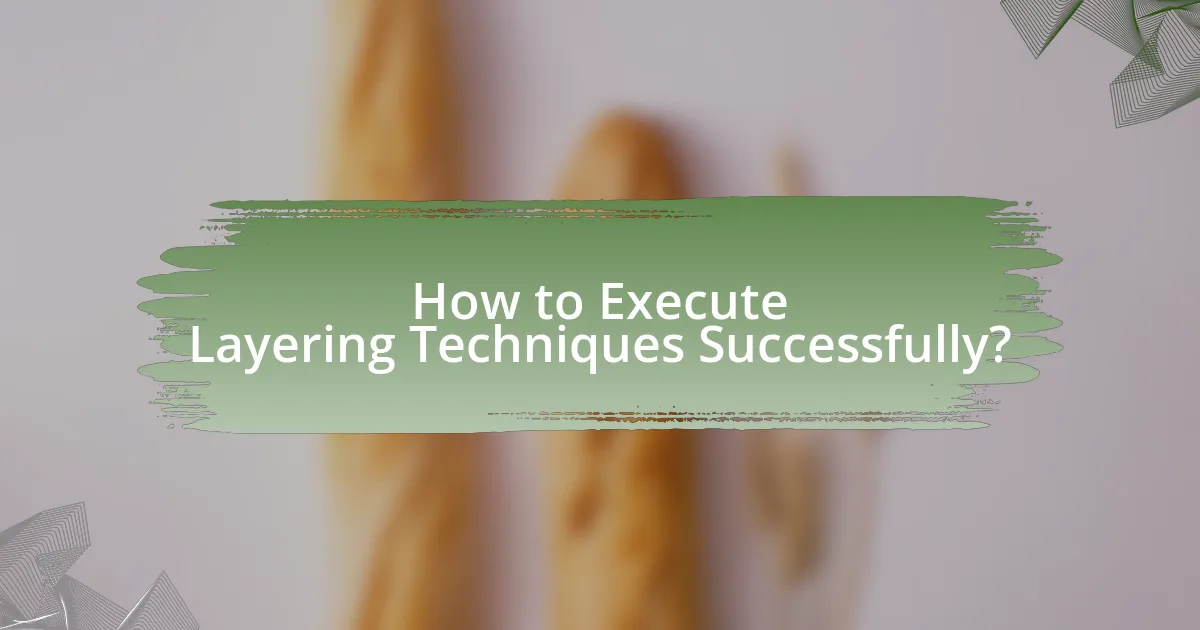
How to Execute Layering Techniques Successfully?
To execute layering techniques successfully, ensure each layer of the cake is level and stable before adding the next. This involves using a serrated knife to trim the tops of each cake layer for evenness, applying a layer of frosting or filling between each tier to secure them, and using dowels or supports for larger cakes to prevent collapsing. Research indicates that a well-structured cake with proper support can maintain its integrity during serving, as demonstrated in baking studies that emphasize the importance of stability in multi-tier constructions.
What are the step-by-step instructions for layering a multi-tier cake?
To layer a multi-tier cake, follow these step-by-step instructions: First, bake each tier of the cake in separate pans, ensuring they are of equal diameter for stability. Once cooled, level the tops of each cake layer using a serrated knife to create a flat surface. Next, place the bottom tier on a sturdy cake board and apply a layer of frosting on top to act as glue for the next tier. Carefully position the second tier on top of the frosting, ensuring it is centered. Repeat this process for additional tiers, applying frosting between each layer. After stacking all tiers, apply a crumb coat, which is a thin layer of frosting to seal in crumbs, and refrigerate the cake for about 30 minutes. Finally, apply a final layer of frosting to the entire cake, smoothing it out for a polished finish. This method ensures stability and a professional appearance for your multi-tier cake.
How do you prepare each layer for stacking?
To prepare each layer for stacking, ensure that each cake layer is completely cooled before assembly. Cooling prevents melting of frosting and maintains structural integrity. Additionally, level the tops of the layers using a serrated knife or cake leveler to create a flat surface, which promotes even stacking and stability. Finally, apply a thin layer of frosting, known as a crumb coat, to seal in crumbs and provide a smooth base for the final layer of frosting. This method is widely recognized in baking practices for achieving a stable and visually appealing multi-tier cake.
What techniques ensure even frosting between layers?
To ensure even frosting between layers, use a technique called “crumb coating.” This involves applying a thin layer of frosting to the cake to seal in crumbs, creating a smooth surface for the final layer of frosting. After the crumb coat sets, apply a thicker layer of frosting evenly across the top and sides of each layer, using a spatula or bench scraper for precision. Additionally, chilling the cake between frosting applications helps the layers set and prevents the frosting from sliding. This method is validated by professional bakers who emphasize the importance of a stable base for achieving a polished finish on multi-tier cakes.
What common mistakes should be avoided when layering cakes?
Common mistakes to avoid when layering cakes include not leveling the cake layers, which can lead to uneven stacking and instability. Additionally, failing to use enough frosting or filling between layers can result in a dry cake, as the layers may not adhere properly. Another mistake is neglecting to chill the cake before stacking, which can cause the layers to shift or slide. Lastly, using overly soft or crumbly cakes can lead to breakage during assembly. These practices are essential for achieving a stable and visually appealing multi-tier cake.
How can improper stacking affect the final cake?
Improper stacking can lead to structural instability in the final cake, causing it to lean or collapse. When layers are not aligned correctly or are unevenly weighted, the cake may not support its own height, resulting in a visually unappealing and potentially unsafe dessert. Additionally, improper stacking can affect the distribution of frosting and fillings, leading to uneven flavors and textures throughout the cake. This is particularly critical in multi-tier cakes, where each layer must be securely supported to maintain the overall integrity and presentation.
What are the signs of a poorly layered cake?
Signs of a poorly layered cake include uneven layers, which can result from improper leveling of the cake layers, leading to instability. Additionally, a poorly layered cake may exhibit excessive bulging or leaning, indicating that the layers are not adequately supported or that the frosting is too soft. Another sign is visible gaps between layers, which can occur if the filling is insufficient or unevenly spread. Lastly, a dry texture can indicate that the cake layers were overbaked or not properly moistened, affecting the overall quality of the cake.
What are some tips for perfecting your layering techniques?
To perfect layering techniques for multi-tier cakes, ensure each layer is level and stable. Use a serrated knife or cake leveler to trim the tops of each cake layer for evenness. Additionally, apply a crumb coat—a thin layer of frosting—to seal in crumbs before adding the final layer of frosting. This technique not only enhances the cake’s appearance but also provides a smoother finish. Furthermore, using dowels or straws for support between layers prevents collapsing and maintains structural integrity. These methods are widely recommended by professional bakers to achieve a polished and stable multi-tier cake.
How can practice improve your layering skills?
Practice enhances layering skills by allowing individuals to refine their techniques through repetition and experimentation. As bakers repeatedly layer cakes, they develop a better understanding of the right amount of frosting, the ideal consistency for cake batter, and the proper alignment of layers. Research indicates that deliberate practice leads to improved performance; for instance, a study by Ericsson et al. (1993) highlights that consistent practice is essential for mastering complex skills. Therefore, through regular practice, bakers can achieve greater precision and creativity in their layering techniques, ultimately resulting in more visually appealing and structurally sound multi-tier cakes.
What resources are available for learning advanced layering techniques?
Online courses, such as those offered by platforms like MasterClass and Udemy, provide structured learning for advanced layering techniques in cake making. These courses often feature professional bakers who share their expertise through video tutorials and step-by-step guides. Additionally, books like “The Cake Bible” by Rose Levy Beranbaum and “Layered: Baking, Building, and Styling Spectacular Cakes” by Tessa Huff offer in-depth knowledge and techniques for mastering multi-tier cakes. Furthermore, YouTube channels dedicated to baking, such as Cupcake Jemma and Bigger Bolder Baking, provide free visual resources that demonstrate advanced layering methods in real-time.
